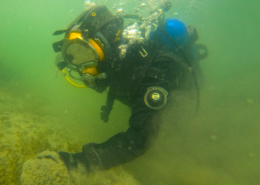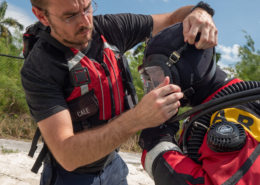Rapid Intervention for Public Safety Divers
By: Bob Shields
The underwater environment has the potential for entrapment, entanglement, loss of air supply, or becoming disorientated similar to that of an interior attack of a structure fire. Why can’t a public safety dive operation have equipment and air staged with the safety divers just like a rapid intervention team (RIT) has for structure fires?
Think about this, a RIT team usually has its members prepared to respond to a trapped or downed firefighter with equipment at the ready along with a secondary air supply. Do most PSD teams plan for this when operating at an incident?
A typical operation
A typical dive operation consists of a primary diver, a safety or backup diver, and an 80 or 90% diver who is at the ready to assume the safety diver’s role if they are deployed. Other than the equipment for each diver to operate with, there is usually little to no staged equipment to aid a diver who is trapped, entangled, or disoriented.
Equipment to carry
There are recommendations from certain training agencies to have a tank and regulator set up and ready to deploy in the event of entrapment. Along with this backup air supply, think about what type of equipment would be needed in the event of a diver emergency.
- Large bolt cutters to cut away rebar, cable or chain.
- A Halligan or pry bar to aid in moving objects that may have fallen or entrapped the diver.
- Sledgehammer to use with the Halligan or to break apart debris.
- A roof ladder to aid in extrication or to help get up onto a dock or the ice shelf.
- Extra rope and hardware to create mechanical advantage systems like a 4:1 haul to move debris or even the diver.
These items along with any other equipment can be staged at the incident site or in a boat and be at the ready if needed. The boat can provide a way to get all the equipment to the area above where the emergency is and equipment can be lowered to the RIT team as it is needed.
Create your own RIT team
If there are enough personnel, utilize them as the RIT team. These members can assist the safety diver in aiding the trapped diver. If there are multiple teams responding to an incident, one of the teams can be designated RIT and prepare for a diver emergency.
As always, have EMS standing by. One ALS (advanced life support) ambulance and crew should be dedicated to the divers in the event of an emergency. EMS providers that regularly respond to dive team incidents should have training in how to manage scuba medical issues. It might be prudent to have the local EMS agency join in on training exercises to see what a scene would look like and discuss with the divers what type of injuries or illnesses may occur.
Training Training Training
Training scenarios such as entanglements and out of air emergencies should be conducted frequently, so all teams and members are familiar with operations to deal with these and other emergencies. Throwing in a surprise emergency during training will test the team’s ability to respond to and manage the situation.
Rapid intervention practices should not be limited to fireground operations. They should be utilized for all emergencies including the disciplines of water rescue and especially dive operations.




 Y. ZIN
Y. ZIN




השאירו תגובה
רוצה להצטרף לדיון?תרגישו חופשי לתרום!